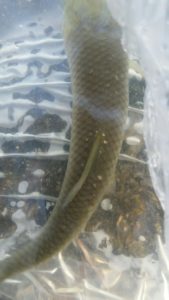Blog
Carp-e Diem! New Denizens of Buckhorn Pond
Have you visited Buckhorn Pond? The spring-fed pond was created after Douglas Bebb built a dam there in the early 1950’s. The pond was designed with an ingenious overflow to protect the dam during heavy rains. Bass, carp and perch make their home here, as well as frogs, turtles and a few snakes. The brilliantly-colored wood duck, spotted sandpiper, heron, and other water fowl are attracted here.
We are responsible caretakers of our property, and invited a representative from the Tennessee Department of Natural Resources to review Buckhorn Pond and provide advice. He told us that our water and surrounding area is in excellent shape! His only recommendation was that a species of carp, the grass carp, could help us more easily maintain optimum levels of water plants.
Grass Carp Released in Pond
Our research revealed that the local farmers’ co-op is visited about once a month by a truck selling live fish. We went there on “fish truck day” and purchased six 12″-long triploid grass carp. The size was important as the naturalist told us if they were too small they could be eaten by the bass, and if they were done growing, they would not eat many water plants.
Innkeeper John and daughter-in-law Sharon took the large plastic bags filled with water and carp down to the pier. They “tempered” the fish by adding water from the pond to the bags until the temperatures equaled. Then they lowered the bags into the water and let the fish swim out. They report the fish looked happy in their new home!
The grass carp is a large, herbivorous, fresh-water fish. It is used as a food fish in China, but in the United States and Europe used mainly for controlling aquatic weeds. The use of these fishy friends lessens use of herbicides. The fish live up to 11 years and eat three times their weight in vegetation daily. They grow rapidly, as much as 10 inches in a summer. The average length of a fully-grown grass carp is around 30″. The grass carp are sterile and will not produce young in our pond.
For more information on stocking ponds, visit http://tn.gov/twra/article/fish-for-stocking.






Gatlinburg Weather
Click for weather forecast